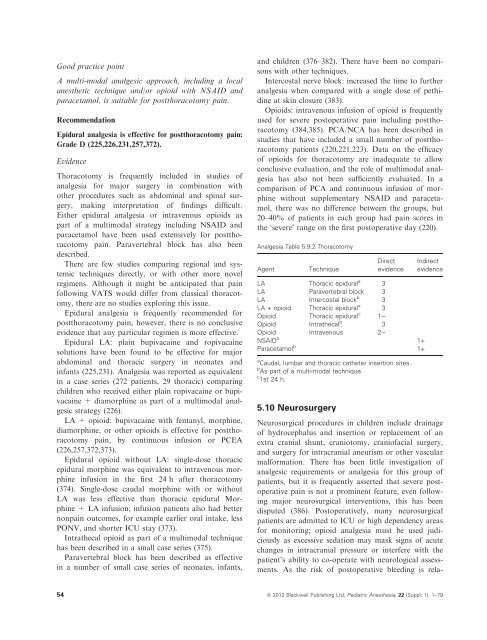Good Practice in Postoperative and Procedural Pain Management ...
Good Practice in Postoperative and Procedural Pain Management ...
Good Practice in Postoperative and Procedural Pain Management ...
You also want an ePaper? Increase the reach of your titles
YUMPU automatically turns print PDFs into web optimized ePapers that Google loves.
<strong>Good</strong> practice po<strong>in</strong>tA multi-modal analgesic approach, <strong>in</strong>clud<strong>in</strong>g a localanesthetic technique <strong>and</strong>/or opioid with NSAID <strong>and</strong>paracetamol, is suitable for postthoracotomy pa<strong>in</strong>.RecommendationEpidural analgesia is effective for postthoracotomy pa<strong>in</strong>:Grade D (225,226,231,257,372).EvidenceThoracotomy is frequently <strong>in</strong>cluded <strong>in</strong> studies ofanalgesia for major surgery <strong>in</strong> comb<strong>in</strong>ation withother procedures such as abdom<strong>in</strong>al <strong>and</strong> sp<strong>in</strong>al surgery,mak<strong>in</strong>g <strong>in</strong>terpretation of f<strong>in</strong>d<strong>in</strong>gs difficult.Either epidural analgesia or <strong>in</strong>travenous opioids aspart of a multimodal strategy <strong>in</strong>clud<strong>in</strong>g NSAID <strong>and</strong>paracetamol have been used extensively for postthoracotomypa<strong>in</strong>. Paravertebral block has also beendescribed.There are few studies compar<strong>in</strong>g regional <strong>and</strong> systemictechniques directly, or with other more novelregimens. Although it might be anticipated that pa<strong>in</strong>follow<strong>in</strong>g VATS would differ from classical thoracotomy,there are no studies explor<strong>in</strong>g this issue.Epidural analgesia is frequently recommended forpostthoracotomy pa<strong>in</strong>; however, there is no conclusiveevidence that any particular regimen is more effective.Epidural LA: pla<strong>in</strong> bupivaca<strong>in</strong>e <strong>and</strong> ropivaca<strong>in</strong>esolutions have been found to be effective for majorabdom<strong>in</strong>al <strong>and</strong> thoracic surgery <strong>in</strong> neonates <strong>and</strong><strong>in</strong>fants (225,231). Analgesia was reported as equivalent<strong>in</strong> a case series (272 patients, 29 thoracic) compar<strong>in</strong>gchildren who received either pla<strong>in</strong> ropivaca<strong>in</strong>e or bupivaca<strong>in</strong>e+ diamorph<strong>in</strong>e as part of a multimodal analgesicstrategy (226).LA + opioid: bupivaca<strong>in</strong>e with fentanyl, morph<strong>in</strong>e,diamorph<strong>in</strong>e, or other opioids is effective for postthoracotomypa<strong>in</strong>, by cont<strong>in</strong>uous <strong>in</strong>fusion or PCEA(226,257,372,373).Epidural opioid without LA: s<strong>in</strong>gle-dose thoracicepidural morph<strong>in</strong>e was equivalent to <strong>in</strong>travenous morph<strong>in</strong>e<strong>in</strong>fusion <strong>in</strong> the first 24 h after thoracotomy(374). S<strong>in</strong>gle-dose caudal morph<strong>in</strong>e with or withoutLA was less effective than thoracic epidural Morph<strong>in</strong>e+ LA <strong>in</strong>fusion; <strong>in</strong>fusion patients also had betternonpa<strong>in</strong> outcomes, for example earlier oral <strong>in</strong>take, lessPONV, <strong>and</strong> shorter ICU stay (373).Intrathecal opioid as part of a multimodal techniquehas been described <strong>in</strong> a small case series (375).Paravertebral block has been described as effective<strong>in</strong> a number of small case series of neonates, <strong>in</strong>fants,<strong>and</strong> children (376–382). There have been no comparisonswith other techniques.Intercostal nerve block: <strong>in</strong>creased the time to furtheranalgesia when compared with a s<strong>in</strong>gle dose of pethid<strong>in</strong>eat sk<strong>in</strong> closure (383).Opioids: <strong>in</strong>travenous <strong>in</strong>fusion of opioid is frequentlyused for severe postoperative pa<strong>in</strong> <strong>in</strong>clud<strong>in</strong>g postthoracotomy(384,385). PCA/NCA has been described <strong>in</strong>studies that have <strong>in</strong>cluded a small number of postthoracotomypatients (220,221,223). Data on the efficacyof opioids for thoracotomy are <strong>in</strong>adequate to allowconclusive evaluation, <strong>and</strong> the role of multimodal analgesiahas also not been sufficiently evaluated. In acomparison of PCA <strong>and</strong> cont<strong>in</strong>uous <strong>in</strong>fusion of morph<strong>in</strong>ewithout supplementary NSAID <strong>and</strong> paracetamol,there was no difference between the groups, but20–40% of patients <strong>in</strong> each group had pa<strong>in</strong> scores <strong>in</strong>the ‘severe’ range on the first postoperative day (220).Analgesia Table 5.9.2 ThoracotomyAgentTechniqueDirectevidenceLA Thoracic epidural a 3LA Paravertebral block 3LA Intercostal block b 3LA + opioid Thoracic epidural a 3Opioid Thoracic epidural c 1)Opioid Intrathecal b 3Opioid Intravenous 2)NSAID b 1+Paracetamol b 1+a Caudal, lumbar <strong>and</strong> thoracic catheter <strong>in</strong>sertion sites.b As part of a multi-modal technique.c 1st 24 h.5.10 NeurosurgeryIndirectevidenceNeurosurgical procedures <strong>in</strong> children <strong>in</strong>clude dra<strong>in</strong>ageof hydrocephalus <strong>and</strong> <strong>in</strong>sertion or replacement of anextra cranial shunt, craniotomy, craniofacial surgery,<strong>and</strong> surgery for <strong>in</strong>tracranial aneurism or other vascularmalformation. There has been little <strong>in</strong>vestigation ofanalgesic requirements or analgesia for this group ofpatients, but it is frequently asserted that severe postoperativepa<strong>in</strong> is not a prom<strong>in</strong>ent feature, even follow<strong>in</strong>gmajor neurosurgical <strong>in</strong>terventions, this has beendisputed (386). <strong>Postoperative</strong>ly, many neurosurgicalpatients are admitted to ICU or high dependency areasfor monitor<strong>in</strong>g; opioid analgesia must be used judiciouslyas excessive sedation may mask signs of acutechanges <strong>in</strong> <strong>in</strong>tracranial pressure or <strong>in</strong>terfere with thepatient’s ability to co-operate with neurological assessments.As the risk of postoperative bleed<strong>in</strong>g is rela-54 ª 2012 Blackwell Publish<strong>in</strong>g Ltd, Pediatric Anesthesia, 22 (Suppl. 1), 1–79
















